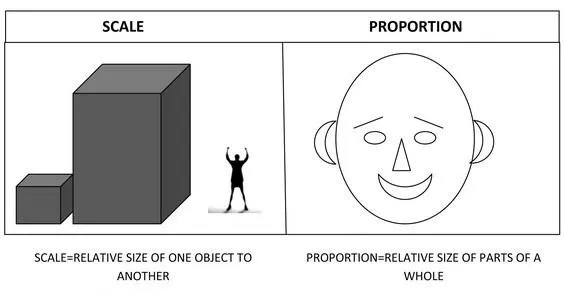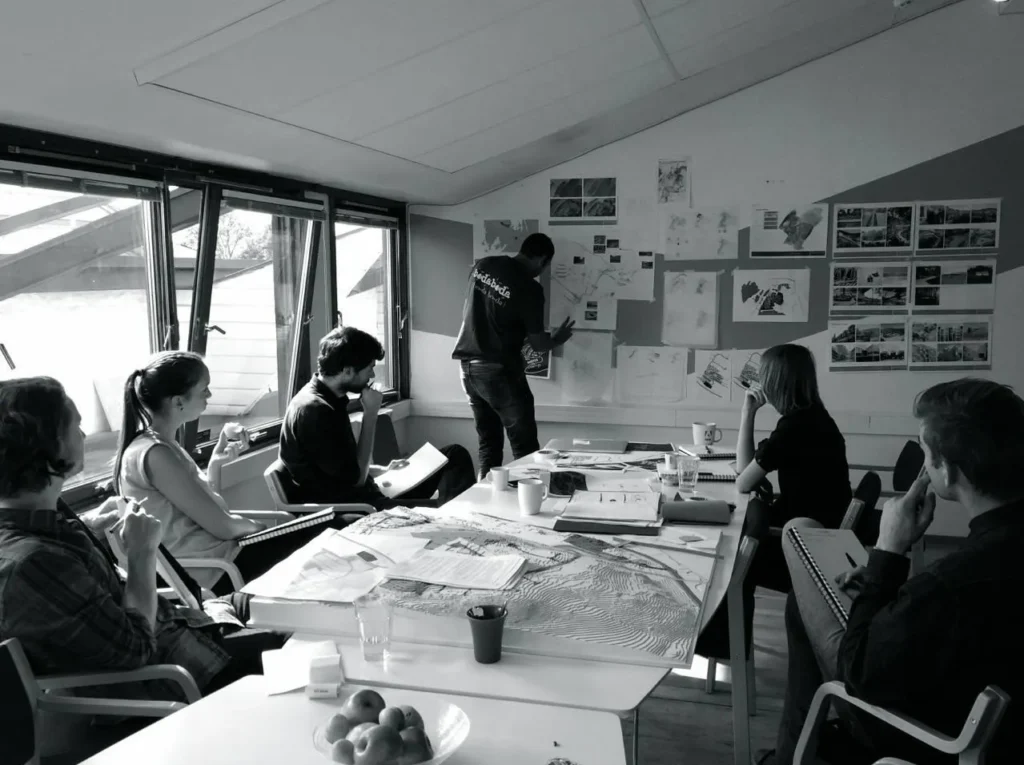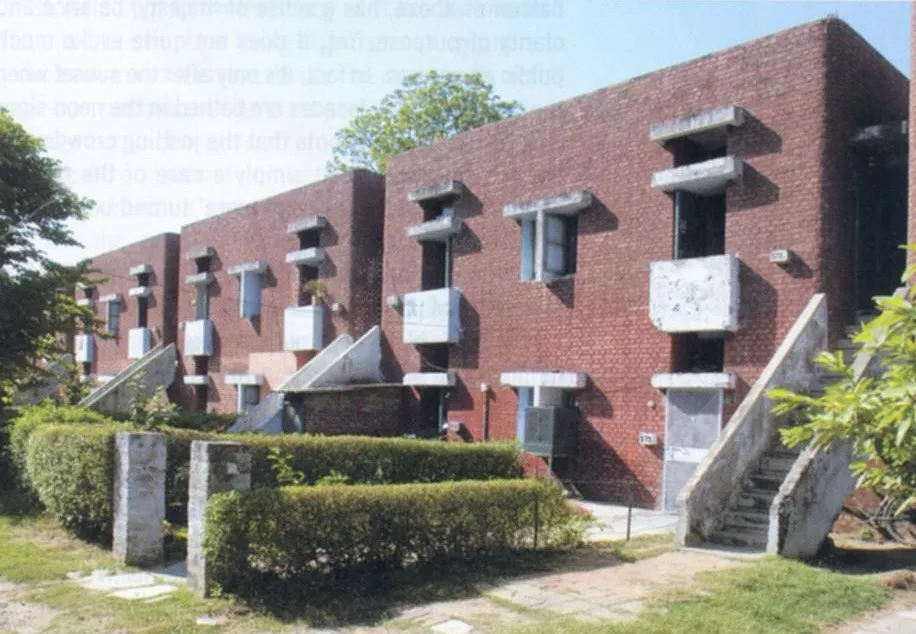If you want to know about the scale and proportion in architecture or difference between design and architecture or geometry in architecture, please click the link.
Scale in architecture refers to the proportion between the size of a building or object and its surrounding environment, as well as the size of its individual parts in relation to each other. It is an important design consideration, as it can affect the perception of a space, create a sense of balance or hierarchy, and affect the functionality of a building.
1) Meaning of scale

- An object by which an unknown quantity is equated to a known quantity. The foot rule that is used for drawing is also a scale. It helps in drawing lines of specific known lengths.
2) Meaning scale in architecture

- Scale refers to the size of an object (a whole) in relationship to another object. Scale refers to the relationship between two or more objects, one that has a commonly known size.
- In most cases, the size of objects is compared to our own human scale.
- The relative size of different objects or of an object to a common standard.
- It is a progressive classification of some quality like size, amount, importance, or rank.
- A single object has no scale until it’s seen in comparison with something else.
3) Drawing Scale

- This is a scaled drawing.
- The ‘scale’ used here is not architectural scale – it is a drawing scale.
- Scale is thus also proportions, when a drawing scale represents say 100 cms by 1 cm.
4) Architectural scale ( Conti….)
- Architectural Scale is thus the means by which space, materials, sizes and proportions are made to suit Man.

- Scale in architecture can also be seen as a measure of the relative size of a building or building component in relation to a known unit of measure or customary size for such a component. A person evaluates how large a building or building component is in relation to the human body size and his or her memory of the expected size for such a component.
- Human scale is related to the human If the door is too high or the seat of the chair too small it is out of scale. When the human being feels ‘comfortable’ about any architecture it is to scale.
- When the length and width of a room are incorrectly proportioned then the space can be called out of scale.
- When a window is too large or two small for a wall it is not to scale.
- When the toilet is equal to the bedroom it is out of scale.
- When the height of a room is too much it is out of scale.
5) Types of Scales
In architecture we deal primarily in Three scales:
- Human Scale: Refers to the size and proportion of buildings, spaces, and objects in relation to the human body.
- Intimate Scale: Refers to small and cozy spaces, often with a low ceiling height and an enclosed feel.
- Monumental Scale: Refers to large and grand structures, often with an emphasis on symmetry, proportion, and grandeur.
- There is also another kind of scale which uses exaggeration. It is known as Hierarchical Scale.
i) Human Scale
Human scale refers to the size and proportion of buildings, spaces, and objects in architecture in relation to the human body. It takes into account the average height and size of a person to ensure that the built environment is comfortable and functional for people to use.
This scale is important because it can affect how people feel in a space and can influence their sense of well-being. By designing buildings and spaces at a human scale, architects and designers aim to create environments that are comfortable and accessible for people of all ages, sizes, and abilities.

- Humans interact with their environments based on their physical dimensions, capabilities and limits.
- Buildings scaled to human physical capabilities have steps, doorways, railings, work surfaces, seating, shelves, fixtures, walking distances, and other features that fit well to the average person.
ii) Intimate Scale
Intimate scale refers to the small size and cozy feel of architectural spaces. It is characterized by spaces that are smaller and more personal, often with a low ceiling height and a more enclosed feel. Intimate scale spaces can include residential rooms, private offices, small courtyards, and other similar spaces.
The goal of intimate scale design is to create a sense of comfort and safety, and to provide a space that feels like a personal refuge from the outside world.
This scale is often used in contrast to monumental scale, which is characterized by large, grand structures, and can help to create a sense of hierarchy and visual interest in architectural design.

- Intimate sizes are smaller than what is normal.
- These don’t shock you, but they are smaller than what we expect.

- Not everybody would recognize intimate as a separate category.
- It is more of a sub-category of human-scale.
iii) Monumental Scale
Monumental scale refers to the grand and imposing size of architectural structures, such as large public buildings, monumental works of art, and iconic landmarks. This scale is characterized by large size, high ceilings, and grand public spaces, often with an emphasis on symmetry, proportion, and grandeur.
The purpose of monumental scale architecture is to create a sense of awe and to inspire feelings of awe, wonder, and pride. This scale is often used in public buildings such as government buildings, museums, and cultural centers, as well as in monuments and landmarks that commemorate important events, people, or ideals.

- Designs that dominate the immediate environment. If a building, monument, statue, sculpture, etc is a monumental space, meaning that it is giant compared to human size, is because it wants to show that what it stands for is bigger than life itself (meaning religion, political ideologies, some memorial, etc). Monumental scale is impressive. Our public buildings are monumental.

- Buildings, statues, and memorials are constructed in a scale larger than life as a social/cultural signal that the subject matter is also larger than life.
- Many architects, particularly in the Modernist movement, design buildings that prioritize structural purity and clarity of form over concessions to human scale.
- Our most universal standard of measurement is the human body; that is, our experience of living in our own bodies. We judge the appropriateness of size of objects by that measure.
- Architectural spaces intended to impress are usually scaled to a size that dwarfs the human viewer. This is a device often used in public spaces, such as churches or centers of government.
- The same principle is often applied to corporate spaces through which the enterprise wishes to impress customers with its power and invincibility.
- In contrast, the proportions of a private home are usually more in scale with human measure, and as a result it appears more friendly, comfortable, less intimidating.
Monumental scale architecture can help to create a sense of stability, permanence, and cultural heritage, and can play an important role in shaping the identity of a city or nation.
iv) Hierarchal Scale
Hierarchical scale refers to the use of scale in architectural design to create a sense of visual hierarchy and emphasis. This technique involves exaggerating the size of certain elements or spaces to make them appear more important or dominant in comparison to others.
- Hierarchal Scale deliberate use of relative size in a work of art, in order to communicate differences in importance, Almost always, larger means more important, and smaller means less important.


- Look as this bas-relief sculpture. Notice the size of the king compared to the size of others. (A bas-relief sculpture is a work that is sculpted in the front only. The images appear to be lifted from the surface, but they are not totally free and a true sculpture in the round).
Example of Hierarchal Scale
A building entrance might be designed to be larger and more grandiose than the surrounding spaces, creating a clear visual hierarchy and emphasizing the importance of the entrance. Similarly, a public square might be designed with a large central element, such as a fountain or statue, to create a focal point and establish a hierarchy within the space.
Overall, hierarchical scale is an important tool in architectural design, as it allows designers to create a sense of structure, balance, and visual interest in their designs, and to guide the viewer’s experience of a space.
It is important to appreciate architectural scale to create functional and beautiful architecture. It is also essential to make the architecture acceptable to the users as properly scaled elements will meet the expectations of the users.
6) Aspects of architectural scale
- These are Physical, proportional and human. These classifications are not watertight and will be seen in all designs in some way or the other.
- Physical scale deals with the use of materials. Materials have an associational connotation of strength, so it is difficult to imagine an airport hangar covered with thatch as thatch is associated with only small huts.
- However, modern technology has changed some associations as huge buildings appear to have been made in glass (of course these have steel or concrete structures!)
i) Use of materials effects the architectural scale

ii) Human scale is related to the human dimensions

- If the door is too high or the seat of the chair too small it is out of scale. When the human being feels ‘comfortable’ about any architecture it is to scale.
iii) Scale in objects and spaces

iv) Human being as a unit of scaling

v) Recognizable dimensions and elements: steps, door-windows

vi) Recognizable dimensions and elements: lampposts

vii) Recognizable dimensions and elements: Entrance

7) Scale in spaces
- From the smallest space to urban spaces scale has a role to play.

i) Scale in interiors

ii) Scale in public buildings

iii) Scale in urban situations

- For the correctness of architectural scale, the human eye and the human perceptions are the final judge.
- Physically, however, the appropriate and truthful deployment of material, the use of good proportions of all parts to each other and to the whole and correct use of anthropometrics will produce good architectural scale.
Scales are important in architecture as they help to create a sense of hierarchy, balance, and visual interest in designs. They also play a role in shaping the way that people experience and feel in the built environment, and can influence their sense of comfort, safety, and well-being. By considering these scales, architects and designers can create environments that are functional, accessible, and visually appealing for people to use and enjoy.